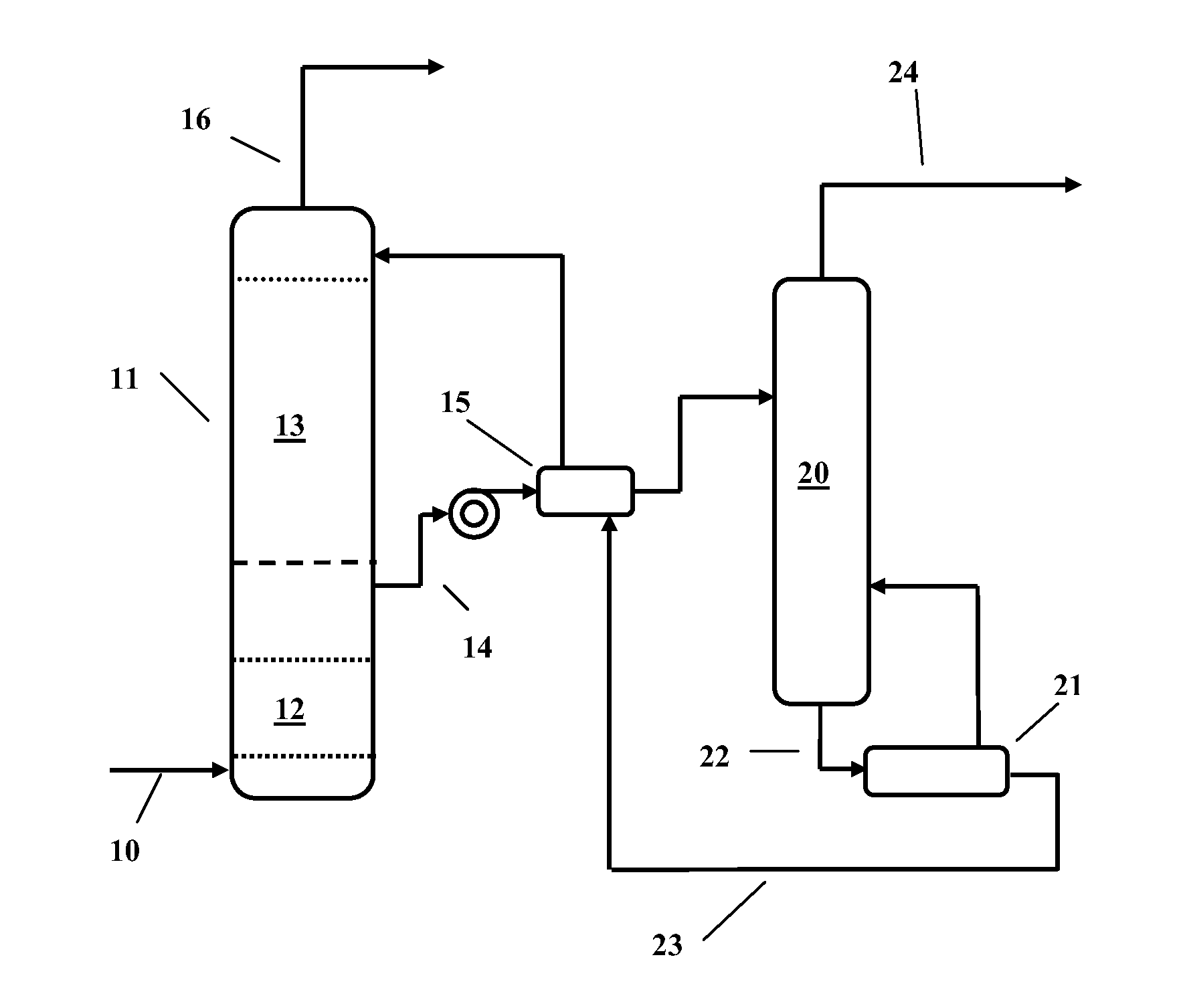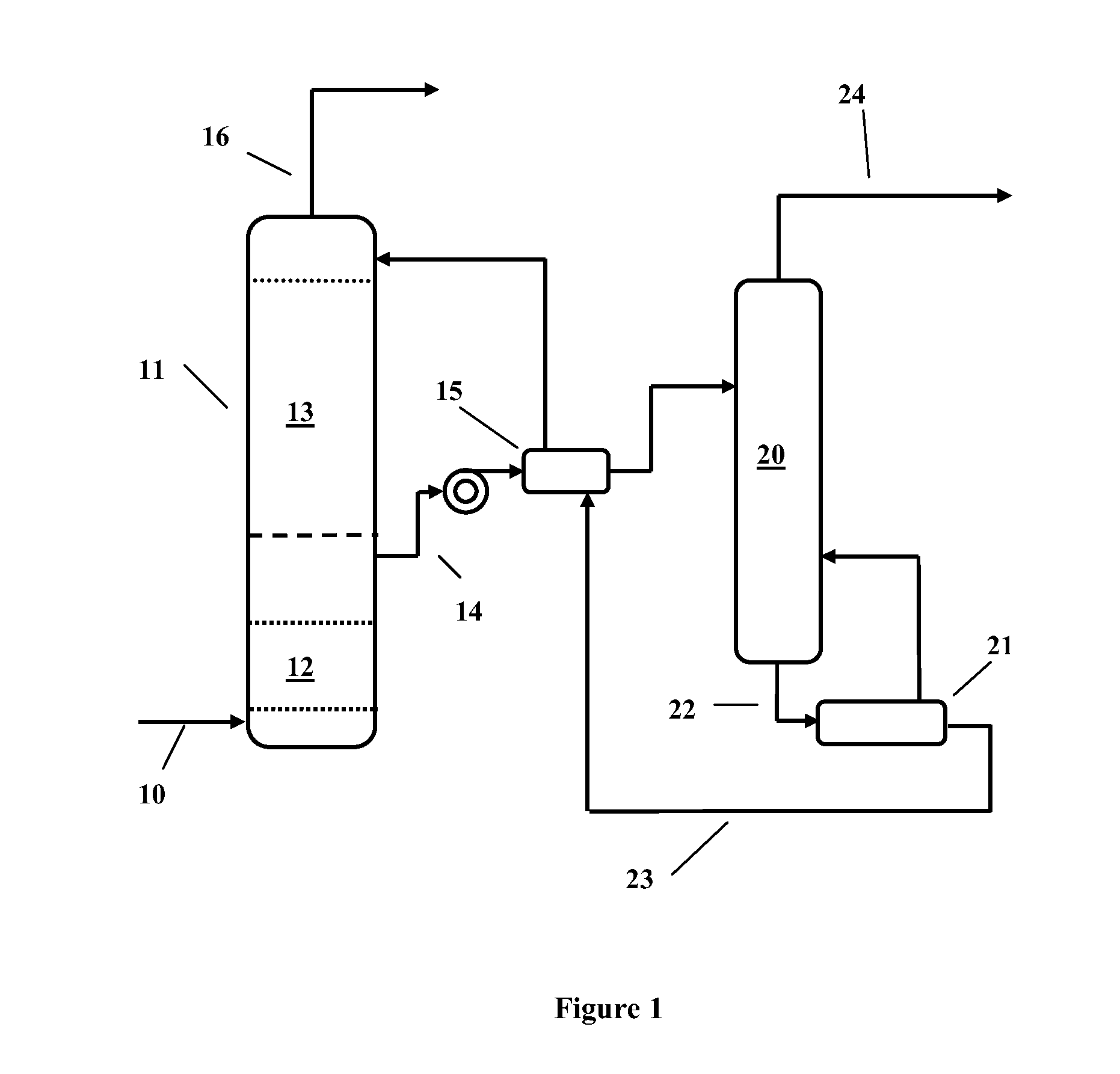Ionic liquids for removal of carbon dioxide
- Summary
- Abstract
- Description
- Claims
- Application Information
AI Technical Summary
Benefits of technology
Problems solved by technology
Method used
Image
Examples
example 1
Reversible CO2 Chemisorption by C-Carboxylation of 1-Ethyl-3-methylimidazolium Acetate
[0056]An approximately 1:2 molar solution of 1-ethyl-3-methylimidazolium acetate in d6-DMSO was prepared in a ˜5 mm NMR tube fitted with a plastic cap and capillary dip tube. The NMR tube was placed inside a ˜5 mm narrow-bore Bruker Avance III™ 400 MHz NMR spectrometer with a QNP probe. CO2 (˜1 atm, or ˜100 kPa partial pressure, and at ˜3-5 cc / min flow, as measured by a Brooks 5896™ flow controller) was bubbled through the room temperature (˜20-25° C.) solution for approximately 3 hours. Comparison of the 1H NMR spectra before and after carboxylation (FIG. 2) shows that the imidazolium C2 C—H proton (˜10.55 ppm) decreased in integration, and a new proton resonance attributed to the carboxylated product appeared at ˜15.76 ppm. The 13C NMR spectra showed that new C2 (C—CO2−) and carboxylate (C—CO2−) resonances appeared at ˜141.55 and ˜155.12 ppm, respectively, with splitting of the imidazolium struct...
example 1.1
Reversible CO2 Chemisorption of 1-ethyl-3-methylimidazolium Acetate Promoted by 1,1,3,3-tetramethylguanidine (TMG)
[0060]A procedure similar to Example 1 was carried out using a d6-DMSO solution containing ˜50 wt % of an approximately 1:1 molar mixture of 1-ethyl-3-methylimidazolium acetate and 1,1,3,3-tetramethylguanidine (TMG, pKa ˜15.20). CO2 was bubbled through the room temperature (˜24° C.) solution for approximately 2 hours. The 1H NMR spectrum showed that the C—H proton of the ionic liquid (˜10.66 ppm) and the N—H proton of the TMG (˜5.50 ppm) were apparently represented by a broad peak at ˜9.62 ppm after reaction with CO2. A small peak at ˜10.3 ppm appeared to represent the C2 C—H proton of the unreacted ionic liquid. In the 13C NMR spectrum, new C2 (C—CO2−) and carboxylate (C—CO2−) resonances appeared at ˜141.77 and ˜154.89 ppm, respectively, with splitting of the imidazolium structural carbons and protons into unreacted and carboxylated species (FIG. 4). At the same time, t...
example 2
Reversible CO2 Chemisorption by C-carboxylation of 1-butyl-3-methylimidazolium Acetate
[0062]A procedure similar to Example 1 was carried out using neat 1-butyl-3-methylimidazolium acetate with a drop of d6-DMSO. After a ˜13 hour CO2 purge, the C2 C—H proton (˜10.77 ppm) in the 1H NMR spectrum (not shown) appeared to decrease in integration and move upheld, with a new CO2H resonance appearing at ˜15.04 ppm. New 13C NMR C2 (C—CO2H) and carboxylate (CO2−) resonances (not shown) appeared at ˜141.71 and ˜155.24 ppm, respectively, with splitting of the imidazolium structural carbons and protons into unreacted and carboxylated species. Integration of the carbon spectrum indicated ˜35 mol % formation of the carboxylated product. A peak at ˜159.9 ppm may represent formation of bicarbonate, possibly due to a trace amount of water in the ionic liquid.
PUM
| Property | Measurement | Unit |
|---|---|---|
| Temperature | aaaaa | aaaaa |
| Temperature | aaaaa | aaaaa |
| Temperature | aaaaa | aaaaa |
Abstract
Description
Claims
Application Information
 Login to View More
Login to View More - R&D
- Intellectual Property
- Life Sciences
- Materials
- Tech Scout
- Unparalleled Data Quality
- Higher Quality Content
- 60% Fewer Hallucinations
Browse by: Latest US Patents, China's latest patents, Technical Efficacy Thesaurus, Application Domain, Technology Topic, Popular Technical Reports.
© 2025 PatSnap. All rights reserved.Legal|Privacy policy|Modern Slavery Act Transparency Statement|Sitemap|About US| Contact US: help@patsnap.com



